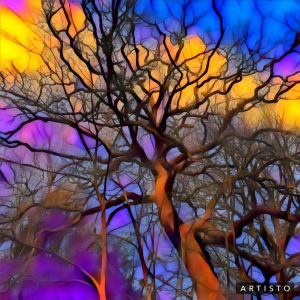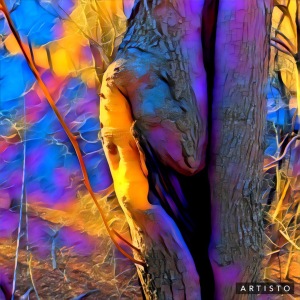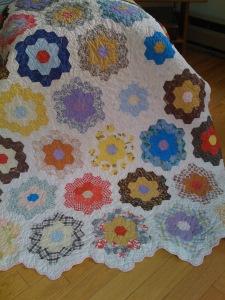My journey to the Unseen has been curious as I reflect upon the process of unfolding I experienced.
First was childhood innocence, one many of us have known, where the Unseen simply ‘were’ and we didn’t really think about it, did we? Later, in my twenties and early thirties, Nature — Blessed Gaia — was my guide and solace; I hiked and wandered along wilderness trails feeling the Unseen as Presences, but more on a subconscious level as I reveled in the beauty and healing. Eventually, conscious connection and receptivity began in my early thirties when I found Goddess and Wicca, a spectacular gift that came into my life at the perfect moment (as most are in hindsight); with this introduction, I began dipping my toes into a greater ocean than I’d even imagined. For the next couple decades, I moved deeper into the flow of the Unseen, slowly and consciously opening to relationship with the Divine, with the Unseen, diving into caves of unknowing to discover treasures beyond measure, often in tandem with the vibrational healing arts I studied and offered to others as well as to myself — for nothing is really separate, is it? Now, in my sixties, having been with many dying beings as they transitioned, having learned so much that I realize I know almost nothing, I have been for several years moving into a more vibrant relationship with the Unseen on the astral byways.
Many people (mostly writers) and traditions are expressing a variety of paths to choose from on this latest intersection at the crossroads of life. No doubt, my own trail will be laden with alchemical flowering, an experience unique to me, as it is for each of us even amidst the similarities, when we adventure beyond the veil into relationship with the Unseen.
Who are the Unseen? So many possibilities, expressions, and manifestations! Most people get stuck on calling all of them the Fae, but those (for me) are only one realm, maybe more, but I don’t want to lump everything together under the Fae. Consider also: lights, apparitions, angels, ancestors, spirit guides (animal, plant, mineral, and more), tulpas, cryptids and other beings from parallel universes, magical beasts, so-called ‘monsters’ (which can itself include things like religious demons or magical ‘parasites,’ etc.), dimensional and/or alternate reality spirits, elementals, and the infinite variety of daimons (a daimon is not the same as a demon). Where do they come from? A vibrational world that is right next to us, a parallel universe, the Otherworld, the Dream World, and we could go on and on. Our material world is only one of many that exudes and emits life, and what we often call monsters are simply beings so inexplicable and dissimilar to ourselves that we fear them. Although I refer to them all as the Unseen, as Greer puts it, “the problem is that people see them.” Right? Otherwise, ancient and/or indigenous stories wouldn’t exist.
“The word ‘monster’ comes from the Latin monstrum, ‘that which is shown forth or revealed.’ … and to the Ancient Greeks and Romans, for example, the appearance of any strange being was a message from the hidden realms of existence.” ~ John Michael Greer, “Monsters: An Investigator’s Guide to Magical Beings”
I highly recommend Greer’s book (quoted from above), but even more, I agree with Greer’s assessment of Patrick Harpur’s modern-classic “Daimonic Reality: A Field Guide to the Otherworld” (that I read a couple years ago and need to re-read because I’ve come further now in my own adventures) as an extraordinary must-read for anyone interested in the Unseen (that, as it happens, many many people DO see!). And if you intend to delve further into contacting the Unseen, Josephine McCarthy’s “The Magical Knowledge Trilogy” is excellent. Magical work for me is often related to listening to and learning from the Unseen.
“Central to magic in all its forms is the idea that besides the aspect of the world we perceive with our ordinary senses, there are other aspects, subtler and stranger, which interpenetrate our ordinary world at every point and shape it by means of hidden connections. Magical theory speaks of various realms or levels of being, all of them interconnected, all present at every moment and in every phenomenon. … They are other aspects of the world we inhabit.” ~ John Michael Greer, “Monsters: An Investigator’s Guide to Magical Beings”
Some skeptics may refer to everything above as pure imagination (or delusion) but what is imagination? No one knows! It may be an Otherworld or it could be the Akashic Records from which ideas or information or stories are being sent (or, alternatively, we consciously access) or something else we’ve yet to uncover or describe. For me, the spiritual journey is vast and I value all of it, from one life to the next.
And, finally, wise words from Murry Hope (an occultist, magician, and metaphysician) in her “Practical Techniques of Psychic Self-Defense”:
“Is everyone suited to pursue the path of occultism, psychism or mysticism? To be absolutely honest the answer must be NO. … The would-be psychic should first of all do some soul-searching and ask himself whether he is temperamentally suited to embark upon the exploration of his own inner consciousness and the greater universal unconscious. … It takes a strong and very stable personality to cope efficiently when exposed to conditions outside the programmed ‘norm.”
The above is particularly resonant for me because it has taken me so many years to feel completely at ease and strong and stable to make these journeys.
Blessings to you on your own journey, however, you choose to travel!



 There is a line I love from
There is a line I love from  I read widely across many genres of fiction and non-fiction, yet find myself curious as to why humans have such a tendency to proclaim that we know what other Beings perceive and conceptualize from within their inter-related experiences of living. I have lived intimately with dogs and cats for most of my life; I can try to guess what one of the blessed beings is thinking, but I cannot know their thoughts. Even people who have psychic gifts still process what they believe they are receiving from an animal or other natural Being, but it may not be entirely valid because they receive through their own context and human nature. This anthropocentric arrogance puzzles and, yes, annoys me.
I read widely across many genres of fiction and non-fiction, yet find myself curious as to why humans have such a tendency to proclaim that we know what other Beings perceive and conceptualize from within their inter-related experiences of living. I have lived intimately with dogs and cats for most of my life; I can try to guess what one of the blessed beings is thinking, but I cannot know their thoughts. Even people who have psychic gifts still process what they believe they are receiving from an animal or other natural Being, but it may not be entirely valid because they receive through their own context and human nature. This anthropocentric arrogance puzzles and, yes, annoys me.

 Imagine all the voices
Imagine all the voices Dogs and cats murmur into our necks
Dogs and cats murmur into our necks Mending this tattered human cloak made from particles of ancestral memories quilted together. Tiny stitches nearly invisible; colorful patches of flowers and the ears of cats lying in wait; embroidered whispers woven into the edges. Mending a life brings in past and welcomes future. This mending is a healing journey. No new clothes unworn; seek the softness of frayed memories upon skin and breathe in the stone-washed shimmer of a resilience not easily wrapped around bones and flesh. Goddess spoke to these women through the stains and strains of life. Like tangled roots reaching down into the hidden caves, the fingers of ancestors – old crooked knuckles move in rhythm with unlined plump digits – touch and soothe, plucking loose threads and darning raggedy connections, bringing the pieces together again.
Mending this tattered human cloak made from particles of ancestral memories quilted together. Tiny stitches nearly invisible; colorful patches of flowers and the ears of cats lying in wait; embroidered whispers woven into the edges. Mending a life brings in past and welcomes future. This mending is a healing journey. No new clothes unworn; seek the softness of frayed memories upon skin and breathe in the stone-washed shimmer of a resilience not easily wrapped around bones and flesh. Goddess spoke to these women through the stains and strains of life. Like tangled roots reaching down into the hidden caves, the fingers of ancestors – old crooked knuckles move in rhythm with unlined plump digits – touch and soothe, plucking loose threads and darning raggedy connections, bringing the pieces together again. Love simply “is.” It is bigger than all of us because Love is Divine. Our human tendency, however, seems to be to rate it or quantify it or make it fit into one of our myriad boxes that make living both easier and more difficult for us.
Love simply “is.” It is bigger than all of us because Love is Divine. Our human tendency, however, seems to be to rate it or quantify it or make it fit into one of our myriad boxes that make living both easier and more difficult for us.